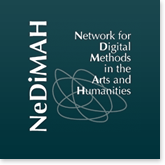
NeMO
The NeDiMAH Methods Ontology ((NeMO)) is a comprehensive ontological model of scholarly practice in the arts and humanities, the development of which is undertaken through the ESF Research Network NeDiMAH.
NeMO is a CIDOC CRM - compliant ontology which explicitly addresses the interplay of factors of agency (actors and goals), process (activities and methods) and resources (information resources, tools, concepts) manifest in the scholarly process. It builds on the results of extensive empirical studies and modelling of scholarly practices performed by the Digital Curation Unit (DCU) in projects DARIAH and EHRI.
NeMO incorporates existing relevant taxonomies of scholarly methods and tools, such as TaDIRAH, the arts-humanities.net and Oxford taxonomies of ICT methods, DHCommons, CCC-IULA-UPF and DiRT, through appropriate mappings of the concepts defined therein onto a semantic backbone of NeMO concepts. It thus enables combining documentary elements on scholarly practices of different perspectives and using different vocabularies.

SCHOLARLY ONTOLOGY & NeMO
Sharing the same layered architecture with Scholarly Ontology (SO), NeMO constitutes an extension of SO for the domain of Digital Humanities. The three-layered structure adopted in NeMO and SO consists of: the Upper Layer that contains the most general concepts and properties, acts as a frame of reference, and provides the basis for compatibility with other reference ontologies; the Middle Layer that contains the hierarchical structures of more specific, but still quite broad properties and concepts which are common across disciplines in the scholarly domain, and the Lower Layer that contains the fine-grained aspects of research practices as well as various controlled vocabularies, specific to each aspect of scholarly work or scientific disciplines.
SO comprises the upper and middle layers. NeMO, on the other hand, consists of SO and a lower layer containing domain-specific extensions of the middle layer concepts, as well as the relevant controlled vocabularies. Likewise, scholarly work ontologies for areas other than the humanities can be generated from SO by developing appropriate lower layer components.